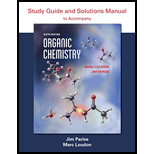
Organic Chemistry Study Guide and Solutions
6th Edition
ISBN: 9781936221868
Author: Marc Loudon, Jim Parise
Publisher: W. H. Freeman
expand_more
expand_more
format_list_bulleted
Question
Chapter 26, Problem 26.47AP
Interpretation Introduction
Interpretation:
The curved arrow mechanism for the given transformation that shows role of pyridoxal phosphate is to be stated.
Concept introduction:
Pyridoxal phosphate is a coenzyme which is an active form of the vitamin
Expert Solution & Answer
Want to see the full answer?
Check out a sample textbook solution
Students have asked these similar questions
a.
•Write all of the possible products
For the Following ronction
А
-----
H
-
H
H
+ H₂0 H+
Н
b. in Rite the complete reaction Mechaniszn
For the Formation of each product.
·C. Suggest what Reaction conditions could
Result in each product being the major
Product of the veaction:
a. Write the product For each of the
Following reactions
H
6-836-6
레
+H₂ N
A
H
A-C-C=C-C-CH + 2 Na +2 NH3 -
H H
b. Write the reaction Mechanism For.
reaction
each
help draw the molecule
Chapter 26 Solutions
Organic Chemistry Study Guide and Solutions
Ch. 26 - Prob. 26.1PCh. 26 - Prob. 26.2PCh. 26 - Prob. 26.3PCh. 26 - Prob. 26.4PCh. 26 - Prob. 26.5PCh. 26 - Prob. 26.6PCh. 26 - Prob. 26.7PCh. 26 - Prob. 26.8PCh. 26 - Prob. 26.9PCh. 26 - Prob. 26.10P
Ch. 26 - Prob. 26.11PCh. 26 - Prob. 26.12PCh. 26 - Prob. 26.13PCh. 26 - Prob. 26.14PCh. 26 - Prob. 26.15PCh. 26 - Prob. 26.16PCh. 26 - Prob. 26.17PCh. 26 - Prob. 26.18PCh. 26 - Prob. 26.19PCh. 26 - Prob. 26.20PCh. 26 - Prob. 26.21PCh. 26 - Prob. 26.22PCh. 26 - Prob. 26.23PCh. 26 - Prob. 26.24PCh. 26 - Prob. 26.25PCh. 26 - Prob. 26.26APCh. 26 - Prob. 26.27APCh. 26 - Prob. 26.28APCh. 26 - Prob. 26.29APCh. 26 - Prob. 26.30APCh. 26 - Prob. 26.31APCh. 26 - Prob. 26.32APCh. 26 - Prob. 26.33APCh. 26 - Prob. 26.34APCh. 26 - Prob. 26.35APCh. 26 - Prob. 26.36APCh. 26 - Prob. 26.37APCh. 26 - Prob. 26.38APCh. 26 - Prob. 26.39APCh. 26 - Prob. 26.40APCh. 26 - Prob. 26.41APCh. 26 - Prob. 26.42APCh. 26 - Prob. 26.43APCh. 26 - Prob. 26.44APCh. 26 - Prob. 26.45APCh. 26 - Prob. 26.46APCh. 26 - Prob. 26.47APCh. 26 - Prob. 26.48APCh. 26 - Prob. 26.49APCh. 26 - Prob. 26.50APCh. 26 - Prob. 26.51APCh. 26 - Prob. 26.52APCh. 26 - Prob. 26.53AP
Knowledge Booster
Similar questions
- How to draw this claisen condensation reaction mechanisms/arrow_forwardWrite all of Me Possible Products For each Of the Following reactions. In each case identity all pains of enantiomers, all digsterzoners and all Meso compounds 9. 11-60 11-0-11 V-G Η Η H ~ C-11 +HB+ - 1 H b. पन्ना 171-0-11 H-C-H Н C-C=c-call +HBr Perendez ==arrow_forwardHow can i draw the mechanisms for this molecule?arrow_forward
- a. Discuss and explain he difference IN Stability between the Chai and Boat Гольцу от судомехане b. For the Following Molecule draw both possible Clain conformations and explain which one is more stable and for what Reason. H. CH₂ CH₂ H "Harrow_forwarddraw out these molecules pleasearrow_forwardhelp draw any straightchain moleculearrow_forward
- How to do the mechanism drawn for the reactionarrow_forwardPlease provide the mechanism for this reacitonarrow_forwardQuestion 5: Name the following compound in two ways using side chain and using prefix amine (Common name and IUPAC name both) CH3NH2 CH3CH2NHCH3 CH₂CH₂N(CH3)2 Draw the structure of diethyl methyl amine Question 6. Write the balanced combustion reaction for: a. Hexane b. Propyne c. 2-pentene Question 7: Write the following electrophilic substitution reactions of benzene: Hint: Use notes if you get confused a. Halogenation reaction: b. Nitration reaction : c. Sulphonation reaction: d. Alkylation reaction: e. Aceylation reaction:arrow_forward
arrow_back_ios
SEE MORE QUESTIONS
arrow_forward_ios
Recommended textbooks for you
 Organic ChemistryChemistryISBN:9781305580350Author:William H. Brown, Brent L. Iverson, Eric Anslyn, Christopher S. FootePublisher:Cengage Learning
Organic ChemistryChemistryISBN:9781305580350Author:William H. Brown, Brent L. Iverson, Eric Anslyn, Christopher S. FootePublisher:Cengage Learning
 EBK A SMALL SCALE APPROACH TO ORGANIC LChemistryISBN:9781305446021Author:LampmanPublisher:CENGAGE LEARNING - CONSIGNMENT
EBK A SMALL SCALE APPROACH TO ORGANIC LChemistryISBN:9781305446021Author:LampmanPublisher:CENGAGE LEARNING - CONSIGNMENT

Organic Chemistry
Chemistry
ISBN:9781305580350
Author:William H. Brown, Brent L. Iverson, Eric Anslyn, Christopher S. Foote
Publisher:Cengage Learning


EBK A SMALL SCALE APPROACH TO ORGANIC L
Chemistry
ISBN:9781305446021
Author:Lampman
Publisher:CENGAGE LEARNING - CONSIGNMENT